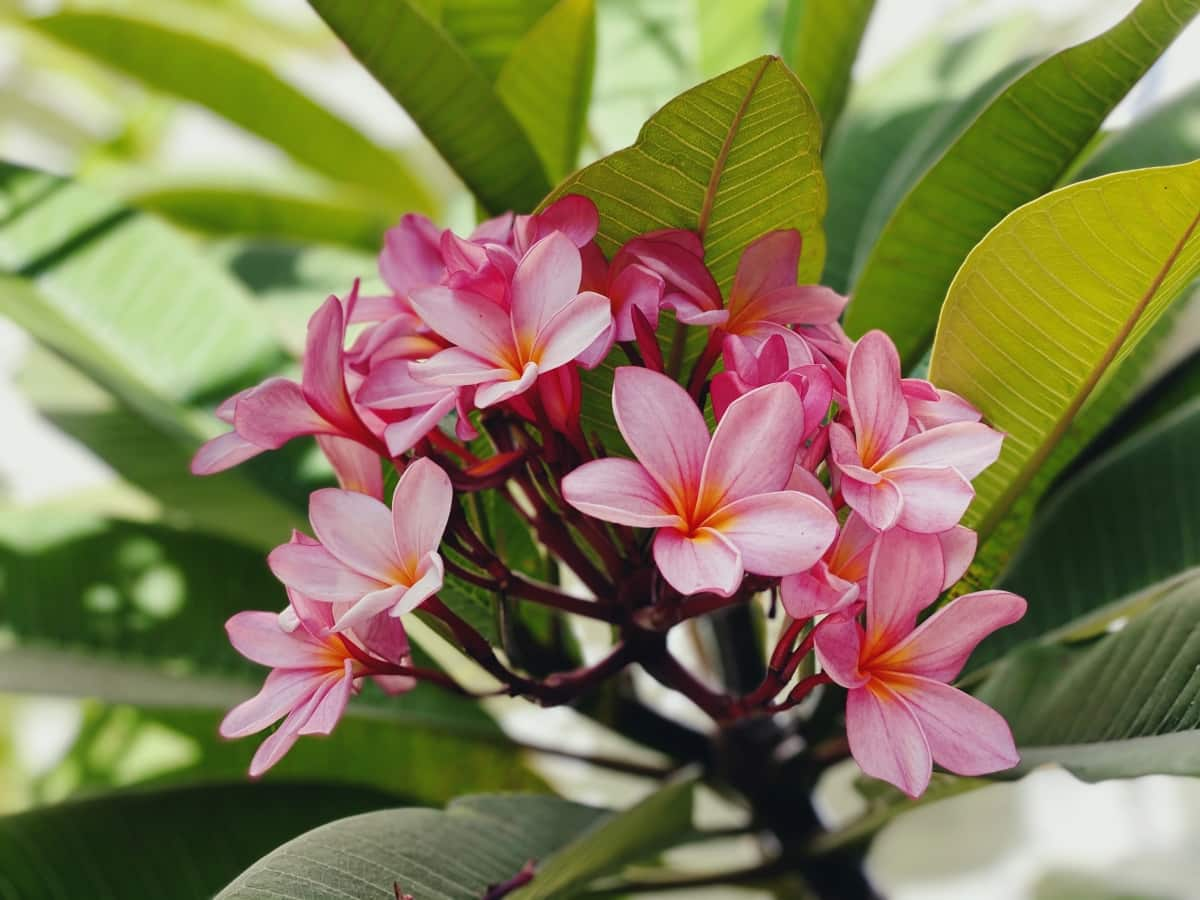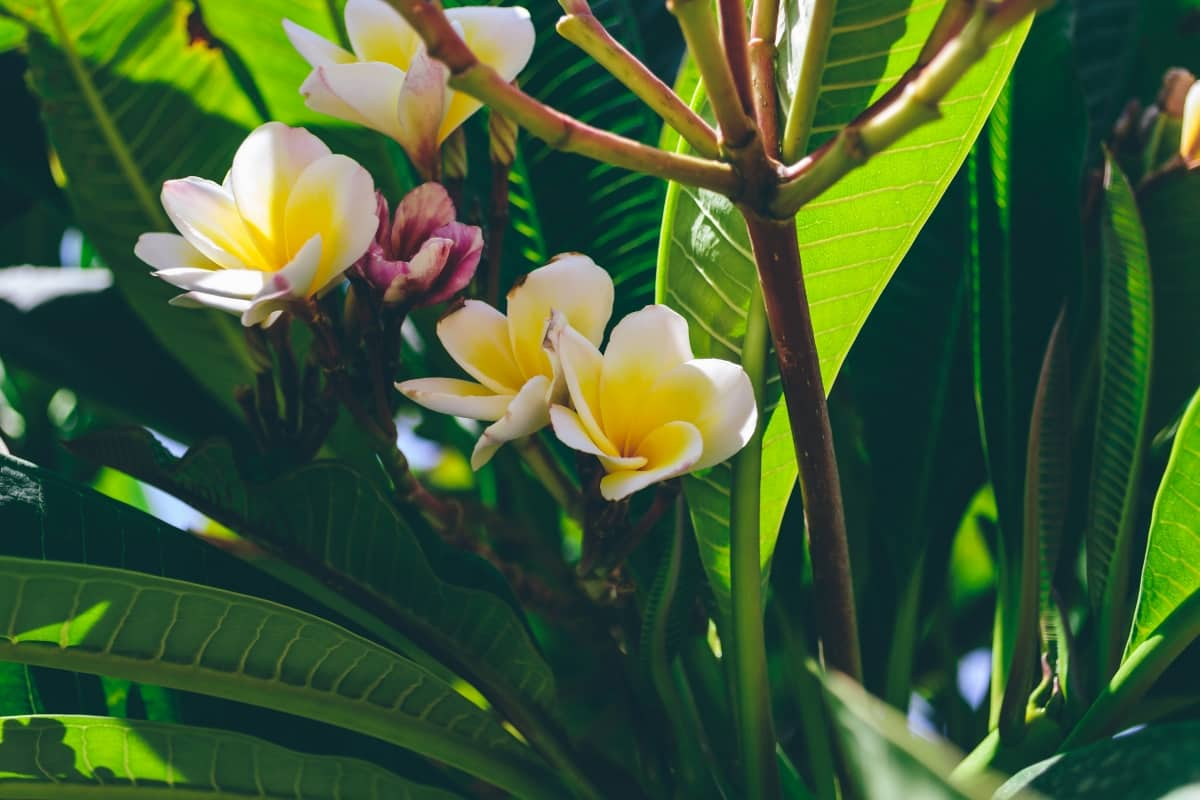Frangipani, also known as Plumeria, is a tropical plant known for its beautiful, fragrant flowers. Their stunning appearance and exotic perfume can turn any garden into a tropical paradise. But to ensure your Frangipani thrives, understanding its nutrition and fertilization needs is key. Like most plants, Frangipani requires specific nutrients to grow, bloom, and resist diseases effectively.

The primary nutrients necessary for healthy plant growth are nitrogen (N), phosphorus (P), and potassium (K), often referred to as the N-P-K ratio in fertilizers. But Frangipani also benefits from secondary nutrients like calcium, magnesium, and sulfur and trace elements like iron, manganese, zinc, copper, molybdenum, and boron.
Best Fertilizer for Frangipani/Plumeria
Choosing the Right Synthetic Fertilizer for Frangipani
Regarding synthetic fertilizers, many options are available in the market. For Frangipani, choose a fertilizer with a balanced N-P-K ratio or one high in phosphorus, which encourages blooming. A ratio of 10-15-10 or 10-30-10 would be appropriate, but a balanced 10-10-10 or 14-14-14 can also work well. Slow-release fertilizers are a great choice for these plants as they gradually release nutrients into the soil, providing a consistent nutrient supply for the Frangipani.
When using synthetic fertilizers, following the manufacturer’s instructions is crucial to avoid over-fertilization, which can damage the plant and degrade the soil’s health. Generally, it is recommended to administer synthetic fertilizers every two to three months throughout the active growth period (spring and summer). However, the frequency may differ based on the particular fertilizer used and the health of both the plant and soil.
The Benefits of Organic Fertilizers for Frangipani
Organic fertilizers are obtained from botanical, zoological, or mineral origins, making them a viable and ecologically conscious substitute for synthetic fertilizers. Organic fertilizers improve the soil structure and increase its ability to hold water and nutrients, providing long-term benefits for your Frangipani. They also release nutrients more slowly than synthetic fertilizers, reducing the risk of over-fertilization.
A good organic fertilizer for Frangipani could be a balanced one like a 5-5-5 or one high in phosphorus like a 5-10-5. Many organic fertilizers also contain beneficial soil microbes that help improve soil health and nutrient availability. Organic fertilizers can be applied in the same way as synthetic ones, every two to three months during the growing season, but always follow the product’s specific instructions.
Home-Made Fertilizers for Frangipani: A Sustainable and Cost-Effective Option
You can also create home-made fertilizers for your Frangipani using kitchen scraps and other household waste. Composting presents an excellent opportunity to recycle organic matter and generate a nourishing compost, which can serve as a valuable source of nutrition for nurturing your Frangipani plant. Compost improves soil structure, increases nutrient content, and promotes beneficial soil organisms.
In case you missed it: The Best Fertilizer for Zinnias: When and How to Apply

You can use green waste like vegetable peels, fruit scraps, coffee grounds, eggshells, and yard waste like grass clippings and leaves to make compost. Avoid using meat, dairy, or diseased plant materials as they can attract pests or spread diseases. The Frangipani plant can benefit from periodic application of compost throughout its growing season, either by directly applying it to the soil or incorporating it during planting or repotting.
Another viable homemade fertilizer alternative involves using banana peels, which are abundant in potassium, a vital nutrient for flower production. To create banana peel fertilizer, collect and chop up the peels, then bury them in the soil surrounding the Frangipani. Gradually, the peels will decompose, gradually releasing their nutrients into the soil. This process can be repeated every few months or whenever banana peels are accessible.
When and How to Apply Fertilizers to Frangipani
Timing and method of application are crucial when it comes to fertilizing Frangipani. As a rule of thumb, fertilization should occur during the plant’s growing season, typically from early spring to late summer. During the period of peak growth, which is characterized by high nutrient requirements, it is recommended to commence fertilizing your Frangipani in early spring when new growth starts.
Apply the fertilizer every two to three months, concluding with the last application in late summer or early fall. This practice guarantees the provision of essential nutrients for sustained growth and blossoming throughout the season, while minimizing the risk of winter damage to new growth. The specific application method may vary depending on the fertilizer type employed.
For granular synthetic or organic fertilizers, apply the granules to the soil surface around the base of the plant, following the manufacturer’s instructions for the recommended amount. Avoid placing the granules too close to the stem to prevent potential damage. After applying the fertilizer, thoroughly water the area to help the granules dissolve, and the nutrients penetrate the soil.
Prepare the liquid fertilizer by combining it with water as per the guidelines provided on the package. Subsequently, apply the resultant mixture to your Frangipani plant by watering it appropriately. Ensure the liquid reaches the root zone of the plant for effective absorption. For homemade fertilizers like compost or banana peels, mix the compost into the top layer of soil, or bury the banana peels around the plant. Then water the area to help distribute the nutrients.
Monitoring and Adjusting Your Frangipani Fertilization Routine
While the above guidelines provide a good starting point, monitoring your Frangipani’s health and adjusting your fertilization routine as needed is essential. Signs that your plant may need more fertilizer include slow growth, small or yellowing leaves, and reduced blooming. If you notice these symptoms, consider increasing the frequency or amount of fertilizer.
On the other hand, over-fertilization can also harm your Frangipani. Symptoms indicating excessive fertilization encompass leaf scorch, drooping, and the formation of a fertilizer crust on the surface of the soil. If you notice these symptoms, reduce the amount or frequency of fertilization, and consider flushing the soil with water to remove excess salts.
In case you missed it: The Best Fertilizer for Bougainvillea: When and How to Apply

Soil testing can also be a valuable tool to understand what nutrients your soil is lacking or has in excess. Many universities and extension services offer soil testing services, or you can purchase a home soil test kit. Use the results to choose the right type of fertilizer and determine the appropriate application rate.
Conclusion
In conclusion, the best fertilizers for Frangipani are those that provide the necessary nutrients for healthy growth and blooming, whether they are synthetic, organic, or home-made. The key is to apply them correctly and at the right time, monitor the plant’s health, and adjust as needed. With a little attention and care, your Frangipani will reward you with its stunning, fragrant flowers for years to come.
- Feed Your Flock for Less: Top 10 Tips to Save on Chicken Feed
- Ultimate Guide to Ossabaw Island Hog: Breeding, Raising, Diet, and Care
- Hatching Answers: The Top 10 Reasons Your Chickens Aren’t Laying Eggs
- Eggs and Economics: Breaking Down the Cost of Raising Backyard Chickens
- Defend Your Greens: Proven Methods to Keep Iguanas Out of Your Garden
- Ultimate Guide to Cinnamon Queen Chicken: A Comprehensive Guide for Beginners
- Ultimate Guide to California Tan Chicken: Breeding, Raising, Diet, Egg-Production and Care
- Ultimate Guide to Marsh Daisy Chicken: Breeding, Raising, Diet, and Care
- 10 Types of Chicken Farming Businesses You Can Start for Profits